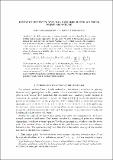Files in this item
Distance between natural numbers based on their prime signature
Item metadata
| dc.contributor.author | Kolossváry, István B. | |
| dc.contributor.author | Kolossváry, István T. | |
| dc.date.accessioned | 2022-10-20T23:36:13Z | |
| dc.date.available | 2022-10-20T23:36:13Z | |
| dc.date.issued | 2022-05 | |
| dc.identifier | 276432700 | |
| dc.identifier | cd9542b8-af52-41ae-abdb-f923123dc37f | |
| dc.identifier | 85118341682 | |
| dc.identifier | 000795908300006 | |
| dc.identifier.citation | Kolossváry , I B & Kolossváry , I T 2022 , ' Distance between natural numbers based on their prime signature ' , Journal of Number Theory , vol. 234 , pp. 120-139 . https://doi.org/10.1016/j.jnt.2021.09.010 | en |
| dc.identifier.issn | 0022-314X | |
| dc.identifier.other | RIS: urn:1D7C051120CE5760079FA1226F6BDC7E | |
| dc.identifier.other | ORCID: /0000-0002-2216-305X/work/102330745 | |
| dc.identifier.uri | https://hdl.handle.net/10023/26227 | |
| dc.description | ITK was financially supported by a Leverhulme Trust Research Project Grant (RPG-2019-034). | en |
| dc.description.abstract | We define a new metric between natural numbers induced by the ℓ∞ norm of their unique prime signatures. In this space, we look at the natural analog of the number line and study the arithmetic function L∞(N), which tabulates the cumulative sum of distances between consecutive natural numbers up to N in this new metric. Our main result is to identify the positive and finite limit of the sequence L∞(N)/N as the expectation of a certain random variable. The main technical contribution is to show with elementary probability that for K=1,2 or 3 and ω0,…,ωK≥2 the following asymptotic density holds limn→∞∣∣{M≤n:∥M−j∥∞<ωj for j=0,…,K}∣∣n=∏p:prime(1−∑j=0K1pωj) . This is a generalization of the formula for k-free numbers, i.e. when ω0=…=ωK=k. The random variable is derived from the joint distribution when K=1. As an application, we obtain a modified version of the prime number theorem. Our computations up to N=1012 have also revealed that prime gaps show a considerably richer structure than on the traditional number line. Moreover, we raise additional open problems, which could be of independent interest. | |
| dc.format.extent | 1776853 | |
| dc.language.iso | eng | |
| dc.relation.ispartof | Journal of Number Theory | en |
| dc.subject | Power-free numbers | en |
| dc.subject | Prime grid | en |
| dc.subject | Limiting densities | en |
| dc.subject | Distribution of primes | en |
| dc.subject | QA Mathematics | en |
| dc.subject | T-NDAS | en |
| dc.subject | AC | en |
| dc.subject.lcc | QA | en |
| dc.title | Distance between natural numbers based on their prime signature | en |
| dc.type | Journal article | en |
| dc.contributor.sponsor | The Leverhulme Trust | en |
| dc.contributor.institution | University of St Andrews. Pure Mathematics | en |
| dc.identifier.doi | 10.1016/j.jnt.2021.09.010 | |
| dc.description.status | Peer reviewed | en |
| dc.date.embargoedUntil | 2022-10-21 | |
| dc.identifier.url | https://arxiv.org/abs/2005.02027 | en |
| dc.identifier.grantnumber | RPG-2019-034 | en |
This item appears in the following Collection(s)
Items in the St Andrews Research Repository are protected by copyright, with all rights reserved, unless otherwise indicated.

